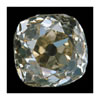The old mine cut was a predecessor of the round brilliant cut. It came into existence in the late seventeenth century. The old miner was the first diamond cut that had all the facets of the present round brilliant cut: the bezel, the star, pavilion mains, etc. However, the facet alignment and sizes were in a different manner as compared to the current round brilliant. The old miner was also more of a square or cushion cut, rather than being round. In fact, today’s cushion cut is an improved old mine cut.
 This cut of diamond is characterized by a high crown, small table, deep pavilion and large culet. Other names for this cut are: old miner, Peruzzi cut, and triple cut brilliant.
This cut of diamond is characterized by a high crown, small table, deep pavilion and large culet. Other names for this cut are: old miner, Peruzzi cut, and triple cut brilliant.
 The old mine cuts did not require the use of a diamond saw in fabrication, so until that piece of equipment was perfected, this cut along with the old European cut were the standards in diamond cutting. Although few contemporary cutters use these facet designs, you will still see them commonly in antique and estate jewelry. These cuts follow the original shape of the rough, and are therefore usually heavy and deep and may have poor symmetry.
The old mine cuts did not require the use of a diamond saw in fabrication, so until that piece of equipment was perfected, this cut along with the old European cut were the standards in diamond cutting. Although few contemporary cutters use these facet designs, you will still see them commonly in antique and estate jewelry. These cuts follow the original shape of the rough, and are therefore usually heavy and deep and may have poor symmetry.
 While being cut with less than exacting proportions, these diamonds have a beauty and magic of their own which give them a desirable, distinct beauty just as the bygone era in which they were fashioned. This cutting style began to disappear around the turn of the century.
While being cut with less than exacting proportions, these diamonds have a beauty and magic of their own which give them a desirable, distinct beauty just as the bygone era in which they were fashioned. This cutting style began to disappear around the turn of the century.

